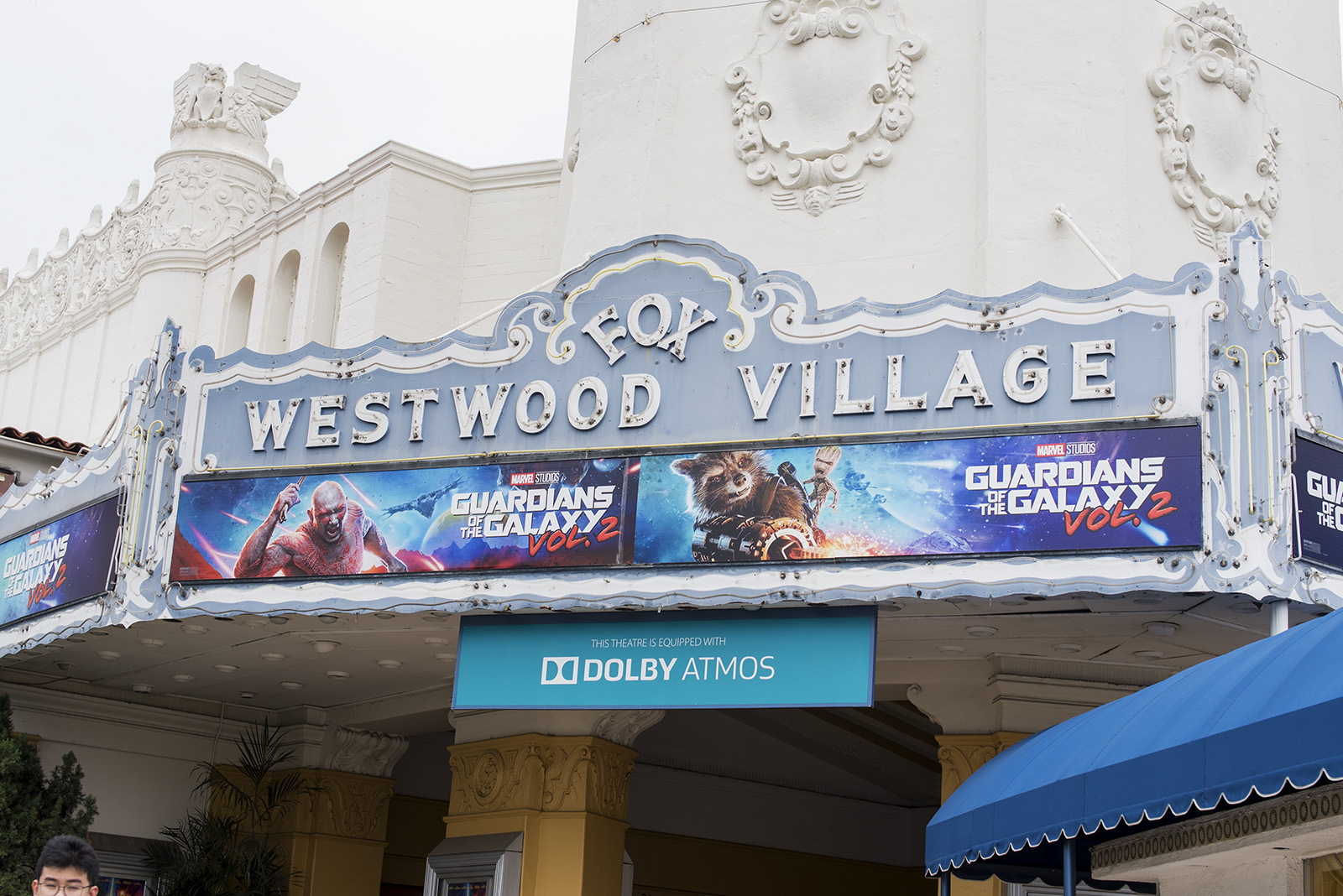The Quad: Hollywood should focus on creativity in film over expanding franchises

“The Guardians of the Galaxy Vol. 2” – a sequel – graced Westwood’s theaters just after “Fate of the Furious” – another sequel. (Miriam Bribiesca/Photo editor)
By Claire Hubert
May 8, 2017 1:35 p.m.
As many Bruins seek refuge from midterm season, many will head into Westwood to see a film to blow off steam. “Guardians of the Galaxy Vol. 2” will premiere in Westwood this Friday, adding to the rash of recent sequels, prequels and remakes that have swarmed the silver screen in recent years.
In 2015, 8 of the top 10 highest grossing movies were prequels, sequel or otherwise related to an already existing franchise. The trend continued into last year as well. Out of the top 10 highest-grossing movies of 2016, five were an iteration of an already existing franchise (“Rogue One,” “Fantastic Beasts and Where to Find Them,” “The Jungle Book,” “Finding Dory,” and “Captain America: Civil War”), whether it be by way of prequel, sequel or remake. A sixth – “Batman v. Superman: Dawn of Justice”– features the two most celebrated comic book heroes ever. While it’s not expressly a sequel, prequel or remake, a battle between well-known superheroes is hardly groundbreaking.
And we’re on track yet again this year to see a plethora of movies that are based on pre-existing content. So far, 11 prequels, sequels or remakes have been released. At least 25 more are planned for release in the next seven months.
Even Pixar, whose president literally wrote a book about the company’s flair for creativity, is falling into the trap: they are currently working on sequels in the Cars, Toy Story and The Incredibles franchises. Disney, their parent company, is also a repeat offender in the art of unoriginal work: recently, they’ve remade classics such as “Cinderella,” “The Jungle Book” and “Beauty and the Beast” into live-action films. Live-action remakes of “Mulan,” “The Lion King,” and “Aladdin” (among others) are reportedly in the works also.
Let’s be frank: I do think some films merit a sequel or prequel. The plot of “The Incredibles 2,” slated for release next summer, has yet to be released, but the eight-year-old in me will be severely disappointed if it doesn’t explore a storyline centered around the mole-like villain featured at the end of the original.
I definitely do not, however, need to see a fifth rendition of “Pirates of the Caribbean” – isn’t Johnny Depp getting a little old to be waltzing around in pirate drag? – nor what one of my friends dubbed “another Michael Bay explosion orgy” installment of the “Transformers” franchise.
There’s no shortage of good writers in Hollywood. In fact, some critics think we are in the middle of a golden age of television. So why do film writers and production companies keep sinking money into film projects that aren’t wholly unique?
One glaring reason is that sequels, prequels and remakes are generally reliable cash grabs. Half of the highest grossing movies of all time are sequels. Most recently, the live-action “Beauty and the Beast” remake grossed over a whopping $750 million, and it’s not done yet.
Franchises are franchises for a reason: there is a clear fiscal incentive to expanding a pop-culture universe. The more installments to a series, the more a company can expand merchandising and exploit fans of that are already part of the culture. Take, for example, the latest expansion of the Harry Potter universe: “Fantastic Beasts and Where to Find Them.” In October, it was announced that the new franchise would include five new movies. However, some critics are left asking if it’s really necessary to extend the universe and franchise so far.
Diehard fans like myself are excited to gobble up anything and everything related to Harry Potter, and that’s kind of the point. Movie executives know it’s an easy buck to make off the fans who made the original franchise – which includes books, movies, merchandise and theme park ticket sales – worth over $25 billion.
We can track a similar phenomena with another devoted fan base – Star Wars fans made “Star Wars: The Force Awakens” the third highest grossing film of all time. I’m sure we can expect similar numbers for December’s “Star Wars: The Last Jedi.”
While some sequels leave viewers scratching their heads – I’m looking at you, “Superbabies: Baby Geniuses 2”– it is important to note that many sequels are very well done. In fact, sequels aimed at kids like “Toy Story 2” and “Toy Story 3” have garnered just as much critical and commercial success as more serious, counterparts, like “The Godfather: Part II” and “Lord of the Rings: The Two Towers.”
So sequels are not always entirely a plague that disgraces the name and institution of the film industry. Nor have they always plagued the film industry. The Golden Age of Hollywood refers to a period of time from the 1930s until the 1960s when Hollywood’s creativity and innovation peaked. Different studios churned out thousands and thousands of films, many of which were in fact sequels. However, as author, filmmaker and critic Stuart Henderson argues, these sequels weren’t as prominent during this golden age because they were often featured as the second part of a double bill, and studios didn’t focus as much time or energy on them as they do today.
If Hollywood wants to remain a juggernaut of innovation and creativity and pursue another golden age of film, they need to continue to pursue wholly original work.


